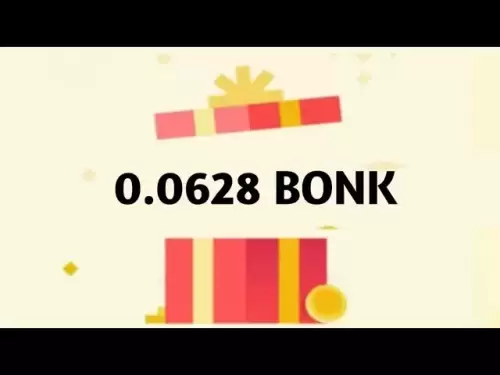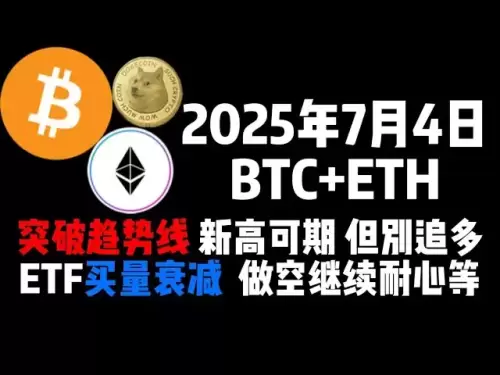-
 Bitcoin
Bitcoin $109,011.2121
-0.90% -
 Ethereum
Ethereum $2,554.1185
-2.06% -
 Tether USDt
Tether USDt $1.0005
0.01% -
 XRP
XRP $2.2311
-2.31% -
 BNB
BNB $658.5491
-0.76% -
 Solana
Solana $150.7662
-3.13% -
 USDC
USDC $1.0000
0.01% -
 TRON
TRON $0.2871
1.22% -
 Dogecoin
Dogecoin $0.1674
-4.20% -
 Cardano
Cardano $0.5832
-3.77% -
 Hyperliquid
Hyperliquid $38.8533
-4.62% -
 Sui
Sui $2.9346
-3.46% -
 Bitcoin Cash
Bitcoin Cash $479.1670
-5.20% -
 Chainlink
Chainlink $13.3735
-3.75% -
 UNUS SED LEO
UNUS SED LEO $9.0432
0.33% -
 Avalanche
Avalanche $18.1550
-4.29% -
 Stellar
Stellar $0.2401
-1.74% -
 Toncoin
Toncoin $2.8152
-3.35% -
 Shiba Inu
Shiba Inu $0.0...01161
-3.82% -
 Litecoin
Litecoin $87.8956
-4.07% -
 Hedera
Hedera $0.1564
-2.39% -
 Monero
Monero $322.9969
-0.77% -
 Polkadot
Polkadot $3.4525
-5.04% -
 Dai
Dai $1.0000
-0.02% -
 Ethena USDe
Ethena USDe $1.0001
-0.01% -
 Bitget Token
Bitget Token $4.5010
-2.55% -
 Uniswap
Uniswap $7.3786
-3.93% -
 Pepe
Pepe $0.0...09810
-8.27% -
 Aave
Aave $270.8275
-3.65% -
 Pi
Pi $0.4843
-4.64%
What is the rate of a perpetual contract?
The funding rate, a periodic payment made between long and short traders in perpetual contracts, aims to align the contract's price with the underlying spot market, promoting price convergence and reflecting market sentiment.
Oct 23, 2024 at 01:54 am

Understanding the Rate of a Perpetual Contract
Perpetual contracts are financial instruments that allow traders to take long or short positions on the price of an underlying asset, such as cryptocurrency, commodities, or indices. Unlike traditional futures contracts, perpetual contracts do not have an expiry date and can be held indefinitely.
Concept of Funding Rate
The rate of a perpetual contract is commonly referred to as the "Funding Rate." It is a periodic payment made between traders who are long (bullish) and short (bearish) on the contract. The purpose of the funding rate is to maintain the price of the perpetual contract close to the price of its underlying index or spot market.
Calculation of Funding Rate
The funding rate is calculated based on the following factors:
- Premium/Discount: The difference between the perpetual contract price and the underlying index or spot market price.
- Cost of Carry: The interest rate differential (basis) between two currencies or assets involved in the perpetual contract.
- Trading Fees: Transaction fees paid by traders to enter or exit a perpetual contract position.
Method of Payment
The funding rate is paid or received every 8 hours (typically at 00:00, 08:00, 16:00 UTC). Traders who hold long positions pay a funding rate to traders who hold short positions if the perpetual contract price is higher than the underlying index or spot market price. When the reverse is true, short traders pay the funding rate to long traders.
Effect of Funding Rate
- Convergence: The funding rate encourages long traders to sell when the perpetual contract price rises above the underlying index, and short traders to buy when it falls below. This helps keep the contract price close to the underlying market price.
- Market Sentiment: A positive funding rate indicates that more long traders are paying the rate, suggesting bullish sentiment in the market. Conversely, a negative funding rate indicates bearish sentiment.
- Profit/Loss: Traders can profit or lose from funding rate payments depending on their position and the funding rate itself.
Example
Suppose the perpetual contract price for Bitcoin (BTC) is $25,000, while the spot market price is $24,900. The funding rate in this case is positive, indicating that traders with long positions are paying traders with short positions. This encourages some long traders to close their positions, pushing the perpetual contract price closer to the spot market price.
Disclaimer:info@kdj.com
The information provided is not trading advice. kdj.com does not assume any responsibility for any investments made based on the information provided in this article. Cryptocurrencies are highly volatile and it is highly recommended that you invest with caution after thorough research!
If you believe that the content used on this website infringes your copyright, please contact us immediately (info@kdj.com) and we will delete it promptly.
- Sui Price Surges Amid Lion Group's Treasury Move: What's Next?
- 2025-07-04 16:30:13
- BLAST Price Bounces Back After Token Unlock: Is the Rally Real?
- 2025-07-04 17:10:16
- Wormhole, Coinbase, and Interoperability: A New Era for Crypto?
- 2025-07-04 16:30:13
- Neo Pepe Coin ($NEOP): The Crypto Meme Coin Aiming to Eclipse Bitcoin & Ethereum?
- 2025-07-04 16:50:12
- Bitcoin Wallet Inactivity Ends: Whale Moves $1B+ BTC After 14 Years
- 2025-07-04 16:50:12
- Bitcoin Reserves, Institutional Adoption, and Cryptocurrency Strategy: A New Era
- 2025-07-04 17:10:16
Related knowledge

How to identify the contract value range in combination with the market profile?
Jul 02,2025 at 10:56pm
Understanding the Market ProfileTo effectively identify the contract value range in combination with the market profile, it's essential to first understand what each concept entails. The market profile is a framework that helps traders visualize how price and time interact across a given period, typically a trading day or session. It provides insights i...

How to use the price slope to filter the false breakthrough signal of the contract?
Jun 20,2025 at 06:56pm
Understanding the Concept of Price Slope in Contract TradingIn contract trading, especially within cryptocurrency derivatives markets, price slope refers to the rate at which the price changes over a specific time period. It helps traders assess the strength and sustainability of a trend. A steep slope may indicate strong momentum, while a shallow slope...

How to determine the expected volatility of the contract through the volatility cone?
Jun 19,2025 at 12:28pm
Understanding the Basics of Volatility in Cryptocurrency ContractsIn the realm of cryptocurrency trading, volatility is a key metric that traders use to assess potential risk and reward. When dealing with futures contracts, understanding how volatile an asset might become over time is crucial for position sizing, risk management, and strategy developmen...

How to formulate a contract intraday trading plan in combination with the pivot point system?
Jun 21,2025 at 03:42pm
Understanding the Basics of Pivot Points in Cryptocurrency TradingPivot points are technical analysis tools used by traders to identify potential support and resistance levels. These levels are calculated using the previous day's high, low, and closing prices. In the context of cryptocurrency trading, where markets operate 24/7, pivot points help trader...

How to adjust the contract position ratio through the price fluctuation entropy?
Jun 22,2025 at 11:42am
Understanding Price Fluctuation Entropy in Cryptocurrency ContractsIn the world of cryptocurrency futures trading, price fluctuation entropy is a relatively new concept used to measure market volatility and uncertainty. It derives from information theory, where entropy refers to the degree of randomness or unpredictability in a system. In crypto contrac...

How to use the volume swing indicator to predict the contract volume-price divergence?
Jun 18,2025 at 11:42pm
Understanding the Volume Swing IndicatorThe volume swing indicator is a technical analysis tool used primarily in cryptocurrency trading to evaluate changes in volume over time. Unlike price-based indicators, this metric focuses solely on trading volume, which can provide early signals about potential market reversals or continuations. The key idea behi...

How to identify the contract value range in combination with the market profile?
Jul 02,2025 at 10:56pm
Understanding the Market ProfileTo effectively identify the contract value range in combination with the market profile, it's essential to first understand what each concept entails. The market profile is a framework that helps traders visualize how price and time interact across a given period, typically a trading day or session. It provides insights i...

How to use the price slope to filter the false breakthrough signal of the contract?
Jun 20,2025 at 06:56pm
Understanding the Concept of Price Slope in Contract TradingIn contract trading, especially within cryptocurrency derivatives markets, price slope refers to the rate at which the price changes over a specific time period. It helps traders assess the strength and sustainability of a trend. A steep slope may indicate strong momentum, while a shallow slope...

How to determine the expected volatility of the contract through the volatility cone?
Jun 19,2025 at 12:28pm
Understanding the Basics of Volatility in Cryptocurrency ContractsIn the realm of cryptocurrency trading, volatility is a key metric that traders use to assess potential risk and reward. When dealing with futures contracts, understanding how volatile an asset might become over time is crucial for position sizing, risk management, and strategy developmen...

How to formulate a contract intraday trading plan in combination with the pivot point system?
Jun 21,2025 at 03:42pm
Understanding the Basics of Pivot Points in Cryptocurrency TradingPivot points are technical analysis tools used by traders to identify potential support and resistance levels. These levels are calculated using the previous day's high, low, and closing prices. In the context of cryptocurrency trading, where markets operate 24/7, pivot points help trader...

How to adjust the contract position ratio through the price fluctuation entropy?
Jun 22,2025 at 11:42am
Understanding Price Fluctuation Entropy in Cryptocurrency ContractsIn the world of cryptocurrency futures trading, price fluctuation entropy is a relatively new concept used to measure market volatility and uncertainty. It derives from information theory, where entropy refers to the degree of randomness or unpredictability in a system. In crypto contrac...

How to use the volume swing indicator to predict the contract volume-price divergence?
Jun 18,2025 at 11:42pm
Understanding the Volume Swing IndicatorThe volume swing indicator is a technical analysis tool used primarily in cryptocurrency trading to evaluate changes in volume over time. Unlike price-based indicators, this metric focuses solely on trading volume, which can provide early signals about potential market reversals or continuations. The key idea behi...
See all articles

























































































